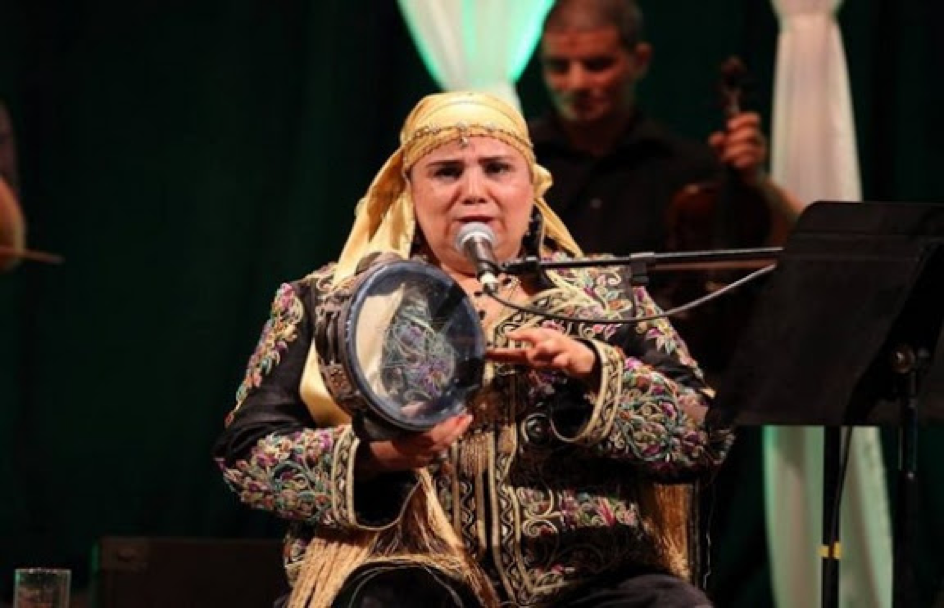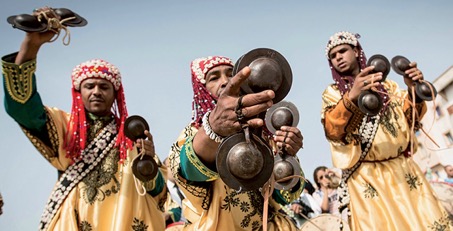HERITAGE AND CULTURAL LIFE
MUSIC
Music in Meknes is rich and varied. It has always expressed the traditions, customs and way of life of people living in Meknes. A wide range of variety including Arabic, Berber, Andalusian and African music.
Meknes is rich through its Arab-Andalusian music, Malhoune, Samaâ and Aissaoui arts.
Arab-Andalusian Music
It is a form of classical music or codified art music that is handed down from teacher to pupil requiring compliance with a set of rules.
It is the heir of the rich history of Muslim Andalusia transmitted with the first waves of emigration of the Arabs expelled from Spain.
Also known as moussiqua al-âla, it is a court music of a very refined civilization. It is a modern to dau synthesis of Arab, Berber and Spanish musical traditions . Morocco’s al-âla repertoire includes eleven noubas.
Malhoun
A true poetic art, Malhoun is better known today as the ‘’quassida of ghazal’.
Originally rising from Tafilalet and Zaouias, Malhoun is the favourite music of the Meknassis.
According to historians, the origin of this music dates back to the 12th century.
It was influenced through the ages by the rhythms of Andalusian music and popular songs that gave birth to the ‘’quassida’ (poetry in Arabic).
It is a music that developed in the past mainly within the craft guilds.
It is in fact a poetry sung in dialectal Arabic, both religious and profane in character, characterized by a sophisticated language and a melody in declamatory style.
Samaâ (audition)
«Audition in Arabic» is an art of sacred a capella polyphonic songs and hymns dedicated to the worship of the Prophet Sidna Mohammed and to Allah.
Samaâ also refers to the musical sessions of the Sufi brotherhoods.
This music was taught in the zaouiyas of Meknes, including zaouiya Alamia.
Aïssaoua art
It is a sort of music coming out from the creation of the religious brotherhood Aïssaoua, founded in the 16th century by Sidi Mohamed Ben Aïssa born in 1465. Coming from the region of Souss, died in Meknes around 1526, he later became «El Cheïkh Kamal», or the «Perfect Cheïkh».
The spiritual centre of the brotherhood lies in Meknes where its founder is buried.
Many wrote about Aïssaoua art as Le Chatelier in 1886 or Brunel in 1926.
Berber music
Meknassi music was influenced by the Berber tribes wo inhabited this region.
This music is divided into «modern» and «traditional», inspired by the striking beauty of the Moroccan rural landscape and the resonance of the bendir that governs the rhythmic of songs, chants and festive dances.
Isn’t it said in the deepest expression of the Berber language that soul resides in the songs and music that are transmitted from generation to generation.
Music of Maâlmates
Meknes is Knowles through the existence of many exclusively female groups called « Maâlmates » who sing Melhoun, Aïssaoua, Chaâbi with their own peculiarity: the Masmoudi rhythm.
SPIRITUALITY AND MOUSSEMS
The sacred and spirituality are manifested through the large number of mosques and zawias in the city.
Among them, the most famous are the mosques Lalla Aouda, Er Rouah, Zitouna, Sidi Kaddour El Alami.
Home to many religious brotherhoods, Meknes also attracts several Sufi communities who gather to practice their rituals for long hours and enter mystical trances in the zaouias.
Meknes is also home to Gnaoua, descendants of former black slaves who came with Moulay Ismaïl and Ahl L'Touat, followers of the tariqa Ouazzania.
Other brotherhoods gave birth to prestigious zaouiyas such as Hmadcha, Sidi Ali, Sidi Ahmed Dghouri. The last two are buried in Meknes.
Moussem of Cheikh el Kamel
One of the most popular brotherhood in Morocco, this religious «Tayfa», founded in the 16th century, takes its name from the holy man of the city ‘El Hadi Ben Issa’, said ‘Cheikh El Kamel’, who practiced a rare way of Sufism which is based mainly on the Hadra.
The ceremony gathers the dances of collective trance to the Sufi songs taking the adept in a long mystical upward journey towards God and the Prophet.
Aïssaoua from every corner of Morocco and even from Algeria, Tunisia and Libya gather each year around the mausoleum of the Cheïkh, the place of the pilgrimage, on the occasion of the Mouloud feast. These practices date from the 16th century.
Cheïkh El Kamel is the founder of the spiritual center of the zaouia of Meknes, where he is buried.
Moussem of Moulay Driss Zerhoun
Between Volubilis and Meknes, the sanctuary of Moulay Idriss I, founder of the first Islamic Dynasty of Morocco, is the scene of one of the most important religious pilgrimages in Morocco. During the annual moussem, the Sufi brotherhood of the Alamiyine inaugurates the ceremonies by the khamra (symbol of ecstasy) which leads the followers through phases more and more gasping to the ecstasy of mystical union with the divine. Then, for eight days, processions of drums and oboes will lead to liberating rhythms of processions, of both confraternities and simple pilgrims, in search of blessings.
Moussem of Sidi Ali Ben Hamdouch
This moussem is held at every Mawlid commemoration on the heights of Zerhoun, near Meknes, the zawiya of Sidi Ali Ben Hamdouch, in the commune of Mghrassyine. During the 7 days of the Moussem, Sufi vigils, psalms, sacrifices of poultry, sheep and cows, and other folk songs are performed by the H'madcha troops, guardians of the temple…
CULTURAL LIFE
FESTIVALS
Meknes International festival of Urban cultures
This International Festival of Urban Arts «Freestyle Morocco Urban Dance» is the Moroccan reference event in terms of Hip Hop Culture, Urban Arts in general and urban dance especially.
This event acquired an international dimension with the participation of a hundred of artists and athletes from a dozen countries and different continents.
In parallel with the competitions, other activities are scheduled: a socio-cultural sports caravan aimed at the animation of the disadvantaged areas of the city of Meknes as well as the towns and villages of the region, conferences, meetings, training workshops….
Meknes international animated film festival
Known in french abreviation as the FICAM, this festival is structured around screenings with the participation of professionals (directors, producers, etc.) as well as exhibitions, debates and meetings with the public. It aims to train and initiate young creators.
International festival of Volubilis, or Meknes-Volubilis
A Moroccan Cultural festival – especially musical –, initiated in 1999 by the Ministry of Culture, in partnership with the wilaya of Meknes-Tafilalet region and the urban municipality of Meknes, in tribute to Volubilis, a site full of history. Since 2011, in order to avoid the degradation of the site, the main activities of the festival take place in Meknes; only its inauguration is held in Volubilis.
Festival of press drawing and humor
This artistic event aims to promote young people's artistic creation in general and that of drawing in particular. It aims to be a fertile space to exchange experiences between artists, actors acting in the field of art and press design.
This festival is a good opportunity to exchange ideas and expertise to better radiate and develop this art while making this artistic event a meeting place of interactivity at first place.
SHOWS
International agricultural show of Morocco
Since 2006, this exhibition brings together for 6 days all the country’s agricultural expertise, in order to boost the agricultural sector by encouraging partnerships and investments.
Among the exhibitors can be found the traditional productions of the terroir, the cooperatives and associations, the large Moroccan agri-food companies, the manufacturers of agricultural machinery, the breeders and their animals, or the main banks and government representatives to provide financial support for agricultural projects.
Within a few years, SIAM became a true international hub and a major event in the African agricultural sector.
It welcomes every year distinguished guests and major operators in world agriculture such as FAO, the European Union, the African Union and different international institutions of the agricultural sector.
CULTURAL CENTERS
The French Institute
Ideally located at the junction of the medina (ancient city) and the modern city, the French Institute of Meknes fulfills a major cultural mission, in this historic and agricultural city, capital of a vast region.
Teaching the French language remains the prior mission of the institute, that develops partnerships with several primary, secondary and higher education institutions: Notre-Dame school, Moulay Ismail university and high school, Paul Valéry high school (AEFE).
Reception times are available from Monday to Saturday in the different spaces offered by the French Institute: language courses, media library, theatre, exhibition gallery.
Rue Ferhat Hachad 50000، Meknes
Tel.: +212 (0) 5355-16500
Michel Jobert cultural center
The literary café and Michel Jobert Cultural Centre in Meknes bear the name of a French politician from Meknes. Michel Jobert was born on 11 September 1921 in Meknes and was Minister of Foreign Affairs between 1973 and 1974, in the Pompidou government.
3 Villa Michel Jobert Rue Pasteur VN - Meknès
Cervantes institute
Annexe de Meknès
19, Rue Pasteur, Résidence Zine El Abidine, Ap. 5
V.N 50 000 - Meknès
Tel.: +212 (0) 535 403 201
infomeknes@cervantes.es
Moulay Idriss Zerhoun cultural center
Moulay Idriss Zerhoun cultural center has a library, an exhibition hall, workshop rooms and a theater.
Maison de la culture
Moulay Idriss Zerhoun, Kheiber
Tel.: +212 (0) 535544675

















